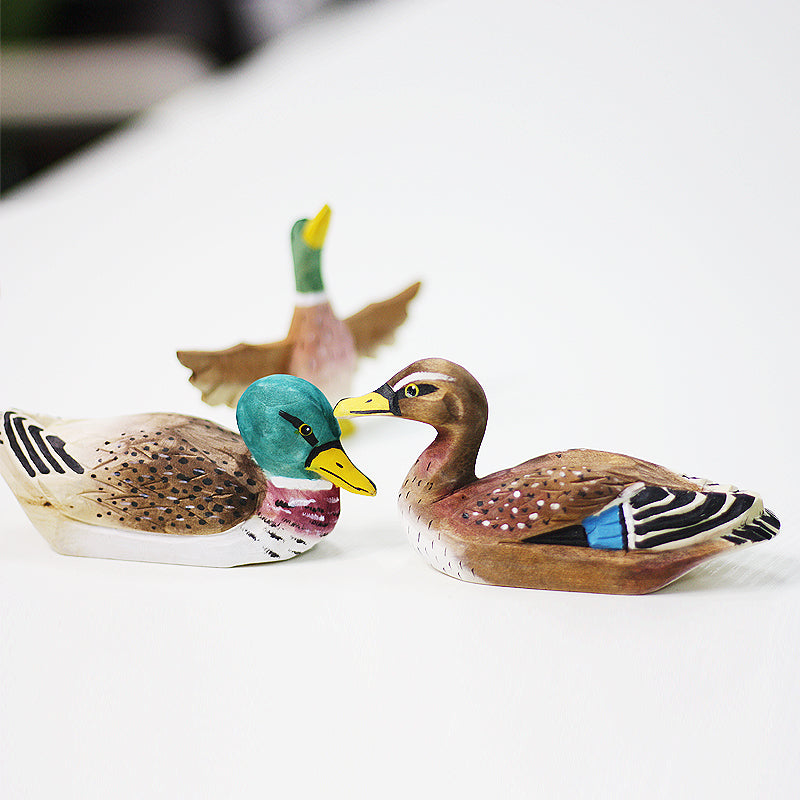
What to Know About Hand-Raising Green-Headed Ducks (Mallards)
Share
What to Know About Hand-Raising Green-Headed Ducks (Mallards)
 Green-headed ducks, often referring to male Mallards, are known for their shimmering emerald head feathers, cheerful quacks, and friendly nature. Hand-raising a Green-headed duck can be a joyful experience—but it also comes with responsibilities that every duck parent should be aware of.
Green-headed ducks, often referring to male Mallards, are known for their shimmering emerald head feathers, cheerful quacks, and friendly nature. Hand-raising a Green-headed duck can be a joyful experience—but it also comes with responsibilities that every duck parent should be aware of.
From fuzzy duckling to a proud adult, here’s a complete beginner’s guide to raising a Mallard by hand.
1. Setting Up a Proper Brooder 🐣
The first step to hand-raising a duckling is setting up a safe and warm brooder.
What you need:
-
A large plastic tub or cardboard box with ventilation
-
Heat lamp or pad to keep the temperature around 32°C (90°F) for the first week
-
Non-slip bedding: towels or rubber shelf liners (avoid newspaper or sawdust)
-
Water bowl (shallow) and small feeder
Ducklings grow fast and are messy—clean daily and change bedding often.
2. Feeding the Duckling Properly 🍽️
Green-headed ducklings need the right diet to grow strong and healthy.
Feed:
-
Unmedicated chick starter feed (20% protein) mixed with water
-
Add chopped greens (spinach, lettuce) from week 1
-
From week 3–4, start adding grains and peas
-
Use a shallow dish for feeding—never force feed
Tip: Add small pebbles (grit) to help them digest greens.
Avoid bread—it's not good for ducks.
3. Water and Hygiene Are Crucial 💧
Ducks love water, but baby ducklings can drown easily.
-
Use a very shallow water dish for drinking
-
No bathtubs or deep water until feathers develop
-
Always supervise water play
-
Dry them with a towel if they get wet before full feathering
-
Change water frequently to avoid bacteria
Water helps with digestion, so never raise ducklings without water access.
4. Bonding and Handling 💞
 Hand-raised ducks form strong bonds with their human caregivers.
Hand-raised ducks form strong bonds with their human caregivers.
-
Start with gentle handling once they are warm and fed
-
Let them sit on your lap or follow your hand
-
Talk softly and offer treats from your palm
-
They love company—never raise a duckling alone if possible
Ducks imprint easily. If you raise them by hand, they may follow you everywhere like a shadow.
5. Outdoor Transition and Exercise 🌿
Once your duckling is 3–4 weeks old and has some feathers, start short trips outside.
-
Let them walk on grass and explore under supervision
-
Avoid exposure to predators or cold weather
-
Always provide shade and a shallow water tray
By 6–8 weeks, your duck will enjoy splashing and waddling freely.
6. Preparing for Adulthood 🦆
An adult Green-headed duck (Mallard drake) needs:
-
Access to a small pond or tub of water
-
Open space to forage, walk, and socialize
-
Shelter from rain, wind, and predators
-
Daily food (duck pellets, grains, veggies)
-
Companionship—either human or other ducks
Mallards are friendly, vocal, and active, and will thrive with attention.
7. Legal and Ethical Considerations ⚖️
Check local wildlife laws. In some areas, keeping or releasing Mallards into the wild is illegal.
If you found an abandoned duckling, contact a licensed rehabber or get approval before keeping it.
If bred domestically, Green-headed ducks (such as domestic mallard types) are often legal to raise.
Always raise ducks ethically and responsibly.
Conclusion
 Raising a Green-headed duck by hand is more than just giving food—it's about providing warmth, protection, and companionship. They’re loyal, expressive, and full of life.
Raising a Green-headed duck by hand is more than just giving food—it's about providing warmth, protection, and companionship. They’re loyal, expressive, and full of life.
If you’re ready for the journey, a hand-raised Mallard will gift you not only quacks and waddles, but also a lifelong bond.














